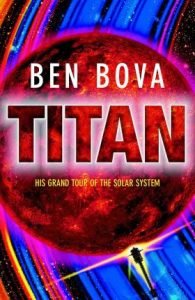Titan by Ben Bova (book review).
‘Titan’ is the second book I have reviewed by Ben Bova. The first was ‘Earth,’ and both form part of Bova’s epic, future-history science fiction saga, ‘The Grand Tour,’ which is a long sequence of novels. When I read ‘Earth,’ I thoroughly enjoyed it and wondered if Bova had captured lightning more than once.
Of course, Ben Bova was not only a well-recognized author but also a six-time Hugo Award-winning editor of “Analogue Science Fact & Fiction,” which he took over editing after John W. Campbell’s death in 1971. Add to this, Bova’s status as President Emeritus of the National Space Society and his service as President of the Science Fiction and Fantasy Writers of America. Clearly, Bova was a titan—if you will pardon the pun—of the SF world and should not be underestimated.
‘Titan’ is another standalone novel in ‘The Grand Tour’ sequence but is set in quite an earlier period than ‘Earth.’. The latter novel was set some time after the predecessors’ visit and the Death Wave, whereas ‘Titan’ is clearly during mankind’s colonisation of the Solar System and thus quite a while prior to those other events. As the reader might suspect from the title, this deals with the first significant exploration of Saturn’s moon, Titan.
The main setting for most of the story is the habitat Goddard, which is home to approximately 10,000 inhabitants. One gathers from the text that, in a previous volume, the habitat almost fell to a rather fundamentalist leadership. Having survived that, Goddard finally arrives at Titan with one Malcom Ebberly residing as chief administrator. Clearly, Ebberly has a history with the aforementioned fundamentalists, as he is now quite paranoid and not above dirty tricks to hold onto his power.
At the start of the book, one of the protagonists, Pancho Lane, is arriving on a torchship named Starpower III. Ms. Lane is an ex-CEO of a large corporation and is accompanied by her partner, Jake Wannamaker, a former admiral of the US Navy. Ms. Lane is ostensibly visiting her sister, Holly, who just happens to be the HR officer for the habitat. The book reveals that most of the inhabitants of Goddard are troublesome folk somewhat exiled from Earth. These include a number of scientists and engineers eager to study Titan or Saturn’s rings.
The head scientist is one Eduard Urbain, who fears dying before he can make a significant and famous contribution to science. In his supporting team, we find Nadia Wunderly, who believes she has found a form of life in Saturn’s rings. Added to these, we have Manny Gaeta, who is a daredevil explorer; Da’ud Habib, who is the habitat’s head computer analyst; and Chris Cardenas, a nanotech expert and lover of Manny Gaeta.
Bova possessed the fortunate ability to craft characters who were both sympathetic and realistically motivated. Ebberley, the administrator, serves as the obvious antagonist, but he is not inherently evil; rather, he is primarily cunning and perceives enemies where none exist. In many ways, Titan itself is the antagonist— certainly to the scientists. The above selection of characters might get the most exposure in the book, but there is a large cast of supporting characters in the sciences, politics, engineering, or just other supporting roles.
As the book rolls majestically on, many of the characters involve themselves in relationships. They frequently engage in competition for individual attention, often with varying degrees of success. Indeed, the characters in this book are very three-dimensional. None of them are perfect, and they all make mistakes or have selfish desires, but all of them are also striving to do the best for the habitat. As such, they all feel vibrantly real, and this is perhaps the most compelling reason to continue reading.
Special mention must go to Bova’s seemingly scientifically accurate descriptions of the surface of Titan and the structural composition of Saturn’s rings. Bova evokes a great deal of beauty and natural awe at the stupendous feats of nature on display. Bova describes the breathtaking view of Saturn and its rings from the Goddard habitat with such superlative beauty that it leaves one breathless.
There are several storylines running throughout the book, which can mostly be boiled down to the scientists’ difficulties with studying Titan and the political struggle mounted by Holly against Ebberly. Given the arrogance of the head scientist, who believes that Goddard’s sole purpose is to serve the mission of science, and Holly’s advocacy for the repeal of the draconian rules against procreation among the inhabitants, we are presented with a compelling drama. In the end, the various storylines come to a satisfyingly natural conclusion with one or two twists that the reader does not really see coming. The resolution is even satisfying for Ebberly, who finds solace from an unexpected angle.
As if things are not clear from my above comments, I am pleased to give a thorough recommendation to anyone even remotely interested in SF. There are plenty of other fine reads for the SF fan these days, but few authors are quite so well-balanced between human nature and the grandeur of cosmic nature. The book both reads as an excellently plotted novel and evokes the wonder of SF.
So far I have read three of Bova’s books, and so far he has scored brilliantly each time. Indeed, I wonder if the rest of Bova’s output was consistently good? This reviewer has at least one more volume to look forward to. If that proves to be equally excellent, then my expectations will come true. Can Bova do no wrong?
Dave Corby
February 2025
(pub: TOR, 2005. 464 page small hardback. Price: $24.95 (US), $33.95 (CAN). ISBN: 0-765-30413-9)
check out website: www.tor.com


